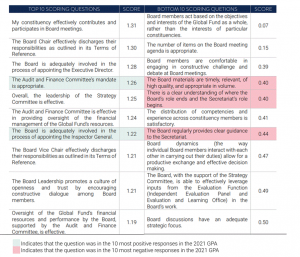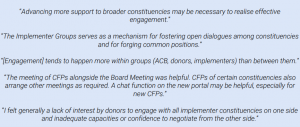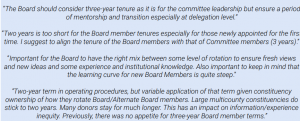
Global Fund 2023-2024 Governance Assessment Report
Author:
Madhuri Kamat
Article Type:Article Number: 2
The Governance Assessment Report 2023-2024 covers the core functions of the Board and examines the responses to a questionnaire as well as interviews to discuss what is working, and what needs improvement in the Board’s relationship with the Secretariat. It also makes recommendations on how they can work better together.
The Global Fund 2023-24 Governance Performance Assessment Report was undertaken by Morrow & Sodali, which was commissioned by the Global Fund. Questionnaires that were part of the survey were tailored to stakeholder categories, which means that not everyone answered all questions (Figure 1).
Figure 1: Scores of Questionnaire

Duty of Care to the Global Fund
After examining the differing definitions of what constitutes “duty of care” across various Global Fund governance documentation, and that the “diversity of its constituencies” is a major plus point as per respondents, a key concern is, that in reality, Board members are perceived to be hard-put to achieve a balance between the Global Fund’s interests and objectives and the interests of their constituency.
Recommendations
After due discussion on exploring the concept of duty of care, the Board should delegate the planning and oversight of activities to the Ethics and Governance Committee (EGC); constituency documents and working should articulate and clearly reflect the onus of fulfilling their duty of care to the Global Fund. This is what constituency members should work towards with their members on the Board and Committee. An example cited of ways of working include setting frameworks within which Board members can engage in unscripted debate, exchange and decision-making towards fulfilling the Global Fund’s mission. There should be inductions and refresher courses for all including Constituency Focal Points reiterating their duty of care to the Global Fund whilst fulfilling their mandate of representing their constituency views.
The Board’s Role and Responsibilities
Strategy Development
Stakeholders broadly agreed that many key aspects of the Board’s role are effectively undertaken. However, concerns remain as reflected in the statements cited in the report.


The lack of discussion on trade-offs and “trying to do more with less” stretches thin the resources of the Global Fund. This also partially affects the Board’s ability for comprehensive discussions on the risk appetite and its management as this strategic risk is overlooked.
Additionally, both the Secretariat and the Board express frustration because the former expects clear guidance from the latter, which the Board’s dynamics and format do not provide. This is compounded by the lack of follow-up on decisions of the Board by the Secretariat as well. There is also discontent that the Board instead of restricting itself to strategic guidance is getting into operational nitty-gritty.

Partnership, Resource Mobilization and Advocacy
There was overall satisfaction across the spectrum that the Board is fulfilling its role of engaging with partners of the Global Fund and raising funds. However, given the upcoming replenishment cycle, there was a feeling that the Board could step up more in this area as the Board’s donor constituency seats’ current profile does not match the current or future funding landscape. New donors need to be incentivized and not just through seat distribution and voting rights.


Commitment of Financial Resources and Assessment of Organizational Performance
This role involves monitoring of funding proposals as well as workplans and budgets across governing, advisory and administrative bodies of the Global Fund with the help of the Audit and Finance Committee, all of which impacts the Global Fund’s financial performance. This was an area where both the Board and Secretariat were seen to be working effectively together.

Governance Oversight
Overall, there was satisfaction on the appointment process of the Executive Director, and the functioning of the Office of the Inspector General, as well as the Technical Review Panel’s recommendations being leveraged by the Board; though some felt more could be done in bringing these into discussions. It would take time to gauge the effectiveness of the Independent Evaluation Panel since it has only recently been created.

Board Dynamics and Functioning
There is a regular practice of Board meetings having representatives read out prepared statements. This was seen to affect the space for interactive discussion, strategic oversight, and clear direction setting. However, responses were mixed on this aspect noting the dynamics behind it.



Meetings necessitate supporting documentation on key issues requiring Board decision-making but there was a sense that it was too voluminous [an issue touched upon in our article on the Strategic Review Report 2023] and there was not enough time to read the materials, which defeats the purpose of meaningful engagement with strategic issues and clear guidance for implementation.


However, the sheer volume is also due to the regular reporting from governing, administrative, and advisory bodies associated with the Global Fund as well. But there is also a trust deficit between the Board and Secretariat, with the latter trying to respond to the range of concerns the Board expects.

The Board meetings like retreats and informal discussion spaces do not always get the expected attendance, especially the latter, frustrating the Secretariat that has to spend considerable resources to prepare and implement.

Despite well-meaning efforts by the Global Fund, the perceived distinction between and power balance between donor and implementer countries remain an irritant. But this is a challenge faced by many in any global and multi-stakeholder organizations.

However, while the above came out in the interview responses, surveys indicated that both donors and implementers felt their participation in decision-making was effective and balanced.
Recommendations
There is a need for all reference documents to be made available on the Board portal; the Board Leadership and the Coordinating Group need “to reimagine Board meeting agendas to maximise time spent on strategic issues and minimise duplication between Committee and Board discussions” and “depending on the issues discussed, Board Leadership may appoint a panel of different Board, Committee, or constituency members as panel members to lead the discussion.”
Board Committees
The Coordinating Group plays a critical role in “acting as a bridge” between the Board and the Secretariat to improve the trust and relationship on both sides. However, the lack of trust may also have led to perceptions of the Coordinating Body being too close to the Executive Director. Moreover, some interviewees were of the opinion that rather than the Board leadership holding the Secretariat to account, the Board leadership and the Executive Director “act seemingly as a collective body”.
![]()
Recommendations
To prevent duplication of materials from Committee meetings being summarized and recycled for Board meetings, the Committee reports should clearly state what issues and questions require a Board response and/or decision. Committee members need to have needed competencies and expertise and where this may not be the case, the EGC should step in and question why they have been nominated. The EGC, only in cases where specific area of expertise is not likely to be available among constituencies, should bring in independent persons with the required qualifications.
Constituency Engagement
More opportunities are necessary for exchange between Constituency Focal Points, especially between donor and implementer groups, as there is little occasion for consistent engagement, and is often restricted to informal dialogues that are few and far between. Focal Points need to share best practices, network and connect with each other. But this is not just about creating opportunities but support for such endeavours.

Hearteningly, the Constituencies and the Board expressed appreciation for the support offered by the Secretariat and Legal and Governance Department.

Recommendations
A specific recommendation was for internal processes among constituencies to provide feedback to their representatives on the Board and the Focal Point against an agreed set of expectations, which could vary across constituencies. On their governance portal, the Legal and Governance Department could open exchange of best practices on prep for Focal Points to engage with the Board as well as actively challenge others when needed.
Board Profile
The issue of representation came up and there was broad agreement that Africa should have a stronger voice in Global Fund governance. Further, the report notes that the traditional donor implementer tags no long work citing the example of Kenya, Nigeria, and South Africa. All of these “are currently included in implementer constituencies, yet at the Seventh Replenishment they pledged more in funding for the Global Fund than some countries included in donor constituencies. Across the entire Seventh Replenishment, 22 implementer countries pledged funding to the Global Fund.”


The age profile of the Board was a matter of concern given the part youth will have to play in the eradication of the three diseases.

While there was concern about the lack of expertise in the Board in certain areas, the report pointed out that these could be sourced from independent experts and rather the focus should be on whether the members had necessary skills in strategizing, and had the gravitas and seniority to carry out their roles. There were also calls for tenure extension of Board members.

Recommendations
Enhance the profile and tenure of Board members. There is already a mechanism in place, which was endorsed in 2018 by the Donor Group, for integration of new donors into existing voting constituencies. This needs to be implemented. Whether or not the overall composition needs to be revised can be considered once there is agreement on strategic priorities.
Relationship between the Board and Secretariat
This aspect was covered extensively in previous sections as well (see above: The Board’s Role and Responsibilities and Board Committees). It was noted that the difference in the tenure of the Board and the length of service of the Secretariat staff led to lack of symmetry in “organizational knowledge and, by extension, contributes to lower degrees of insider understanding and trust.”
Recommendations
To mitigate any tensions there could be an annual check-in between the Management Executive Committee and the Coordinating Group. This could be supported by more informal check-ins by the Executive Director and the Management Executive Committee for the Board and Committees between Board meetings for strategic oversight and direction.
Stakeholder Feedback
Stakeholders showed strong support for the continuance of prepared statements, as it allows for comprehensive and collective views on the agenda items and for Board and Associate Board members to share their consensus positions. There was a suggestion to reduce the number of agenda items to focus on more important strategic and direction-setting issues, including key trade-offs. This would enable those with less resources to participate substantively due to discussions becoming more focused. Another suggestion to make Board meetings more productive was to generate a synopsis that covered aspects of convergence and disagreement, as also any developing trade-offs and tensions. This would ensure that these issues got the attention they deserve so as to resolve them. There is need for action to strengthen accountability.
Conclusion
The report points out that given the time and opportunity costs of informal engagement, it is necessary to structure Board meetings themselves to have open, informal spaces. The report acknowledged that an equitable partnership between constituencies in the long term should be an area of consideration for the Board moving forward and that a process is under review for in-depth and adequate representation of all stakeholders. This is one of those rare reports that actually has direct quotes extensively used to bolster the points made. It is a practice the Global Fund reports need to follow.
